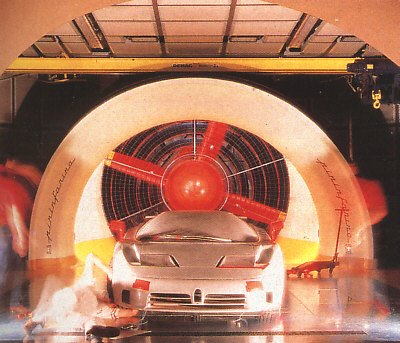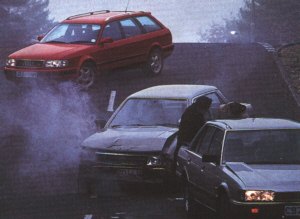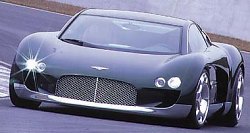 |
 |
Time TunnelNissan Mid-4 This Nissan prototype stunned many of us in 1987. Its name means "mid-engined, 4-wheel-drive, 4-wheel-steering, 4-valve per cylinder and 4 overhead camshafts". The normally aspirated 3-litre VG30DE V6 pumped out 230hp (eventually put into 300ZX's engine bay) and was able to push the car to the claimed 250km/h top speed. In the age before the arrival of NSX, this Ferrari-lookalike sports car was set to outgun the best Western sports cars with its high-tech. Several running prototypes, including the one came Hong Kong and shown in here, were completed and production was said to go. This didn't come true as Nissan didn't think it could be profitable. Now Honda knows Nissan was correct. Next issue we'll see the second generation Mid-4.
|

Oh yes, the contemporary S4 like today's A4-based S4 feels fast and secure but uninspiring to drive compare with BMWs.
|
| Reader's Letter | ||||
|
|
|||



| Isn’t this a strange topic
? If not
stylists, who design our cars ?
Before answering these questions we’d better to understand today’s stylists. Those artists were graduated from Royal College of Art or Art Center of Design or blah blah blah, live in houses with lots of artistic masterpieces, drive Ferrari Dino 206 or Mercedes 300SL to work, without much knowledge about mechanical engineering and aerodynamics. Their ultra-imaginative minds love to create concept cars with 20-inches wheels, windscreen with 15º inclination, bubble glass roof without any rollover protection, gullwing or scissors doors, or cars without B-pillars. Some concept roadsters have half-size windshield, letting the occupants enjoying 150mph air flow as breakfast. Some stylists gave 20mm suspension travel to an ultra-low sports car and called it "Bentley Hunaudieres". Some borrowed all the useless features from a classic car and called it "New Beetle". Because of their skin-deep knowledge about cars, their "masterpieces" usually have to be greatly reshaped for space, ease of access, safety or aerodynamic reasons and ditches many production-impossible element. After the process, their cars become unexpectedly ugly, too ugly to link back to the original sketches. You must argue with me : Isn’t that the Audi TT looks terrific even in the production form ?
Well, from the bold fat proportion and high shoulder line it seems to be a safe design being able to accept all the practical needs. In fact it isn’t. The TT has a drag coefficient of 0.35, the highest of its kind I heard for more than a decade. For such a high performance car you must expect a low aerodynamic lift generated, but the TT once again let us down with its 418N / 567N front and rear lift measuring at 120mph, versus Volkswagen Golf’s 19 / 340N. No wonder Germany magazine Auto, Motor und Sport reported severe high-speed stability problem during a comparison test against TT’s close sister, Audi S3 and VW Golf 4motion. Among the trio, TT is the most powerful and the fastest, it should generate the least lift ! |
Thanks to American stylist Freeman Thomas, who
also designed
the New Beetle. He gifted the TT an unforgettable shape having a large
area liftback in an inclined angle of 30 to 40 degrees, which generates
the most unstable air flow according to aerodynamists. The liftback
curve
smoothly towards not only the tail edge but over the swoopy boot lid
towards
the ground ! This increases the effective area the aerodynamic lift
acted
on.
I can imagine what the aerodynamists from Ingolstadt thought after their first sight at the show car in 1995 Frankfurt motor show. I can imagine how they debate with Mr. Thomas in the management meeting whether to re-design the car. I can imagine the stylist won the battle, but this was also the battle against real drivers. This is why I shout "Stop Stylists from Ruling our Car Design !" Considering its Golf-root, with just 89mm taken out of the wheelbase, the TT should have provided sounded comfort and convenience. But reality is completely different : those who tested it reported horrible visibility all round, thanks to the unnecessarily high shoulder / bonnet / boot line and the unnecessarily low roof line. Also thanks to the roof, mind your head when you’re getting in or out. The rear seats should have been suitable for teenagers, but the swoopy rear window actually limit passengers to 150cm of height (as stated in the warning label). I can’t remember how old when I was 150cm tall. Here you see how an imaginative stylist wasted a good material. Go back to the history, you’ll find most of our favourite classic designs come from engineers, e.g. the Beetle was designed by chief engineer Ferdinand Porsche, Mini by Sir Issigonis, Jaguar SS and XK by Sir William Lyon, who also led the team designing the beauty of the Century, E-type. The 911 was penned by Ferry’s son, stylist Butzi Porsche, but it followed the shape defined by Ferry’s own 356. In these cars you see perfect combination between style and function, if somewhat bounded by contemporary technology. The stylist era started by several Italian studios, namely Pininfarina, Bertone, Zagato and Ghia. Instead of designing mass production cars for car makers, they made money by building special edition on platforms supplied by car makers, enclosing those platforms with |
bodies designed, engineered and built by
themselves. Therefore
they were called "coach-builder". The coach-builders did not really
involve
mass production design or have their own mass production line until
well
after the World War II, by then, they were already experts of car
engineering
so that they knew how to design a beautiful shape without sacrificing
practicality.
Look at the latest Alfa GTV and Peugeot 406 Coupe and you’ll
understand.
Sure, there are guys like Marcello Gandini who have no engineering background and having uncompromising character, but their services are usually bounded to exotic supercars. It is GM of the 50’s brought us the styling gimmicks to everyday cars - super long boot, conical rear lights, aircraft-style vertical rear wings etc. - to distinguish its wide range of similar products. Styling became a matter of fashion. During the past decade, many car makers established their own studio, employed several to a dozen fresh-graduated stylists. As a result, imagination has been replacing coach-builder’s experience and reflected in modern car design. Today’s stylists have to deal with more practical constraints, not only because of the demands feedback from the market but also because of the advance of aerodynamics research and the popularity of platform sharing. Stylists must have basic knowledge of aerodynamics and work closely with engineers. Studio having their own wind tunnel would be even better, such as Pininfarina. Without putting aerodynamics into consideration from the beginning, Ferrari 360 Modena would have been never achieved superior downforce yet looks "reasonably" beautiful. Mr. Freeman Thomas once criticised BMW’s Z3 and Z07 as "going backward" while his Audi is "going forward". The former statement is in no doubt but the latter is quite questionable, at least from engineers’ viewpoint. What makes a ’86 Ferrari Testarossa looks advancer than the original ’58 Testa Rossa is the aerodynamical shape and the improvement of craft and material. Don’t tell me it is the exaggerate side grilles ! - Mark Wan. |